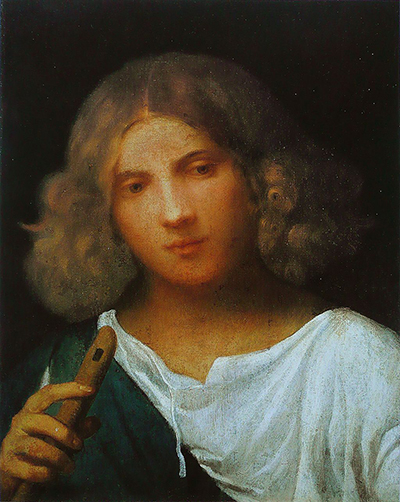Shepherd with a flute, an oil on canvas painting, was executed by Giorgione in 1510–15. In 2018, the painting was at Windsor Castle in the King's Castle. It's now in the British Royal family's Royal Collection. Since 1983, the Royal Collection has called it Boy with a Pipe.
Although some people think that Giorgione did not paint Shepherd with a Flute, the subject and composition are undoubtedly his style; this painting is believed to be a copy of his lost original painting. The painting is similar in mood and composition to Giorgione's Boy with an Arrow in the Vienna-based art museum Kunsthistorisches Museum, which is one of the rare examples of paintings still attributed to the Italian painter. This is partly because Marcantonio Michiel mentioned it in 1531 together with a lost shepherd holding a fruit in his hand.
A young man wearing a loose white shirt is looking away from viewers out of the illusory space; he is lost in thoughts. The boy is holding a woodwind instrument, and it looks like he has just been playing the instrument. X-ray radiography shows that the figure was originally wearing a formal style of a white shirt that has continuous gathers under a greyish-blue doublet. This type of painting originated from Leonardo da Vinci and was taken up by other artists in the early sixteenth century.
Charles I of England purchased the painting at an unknown date. Following the king's execution, the painting was valued at 30 pound and De Critz and Co bought it in 1650. Charles II of England recovered the painting on the English restoration in 1660. It was then hung at Palace of White Hall at Westminster, Middlesex, which was then Kensington Palace. In 1833, it was moved to the royal palace located in the borough of Richmond upon Thames called Hampton Court Palace, which was open to the public at that time and for long displayed the Italian Renaissance paintings found in the Royal Collection. The painting remained there until recently when all the paintings from the Italian Renaissance were moved.
Giorgione left behind a lasting legacy that was developed by Titan and seventeenth-century artists. He never subordinated colour and line to architecture or artistic effect to sentimental presentations. Giorgione was the first painter from Italy to paint landscapes that had figures as moveable images in their own frames without devotional, historical or allegorical purposes. He was also the first Italian painter whose colours had that glowing, melting and ardent intensity, which would later represent the work of the Venetian School.




